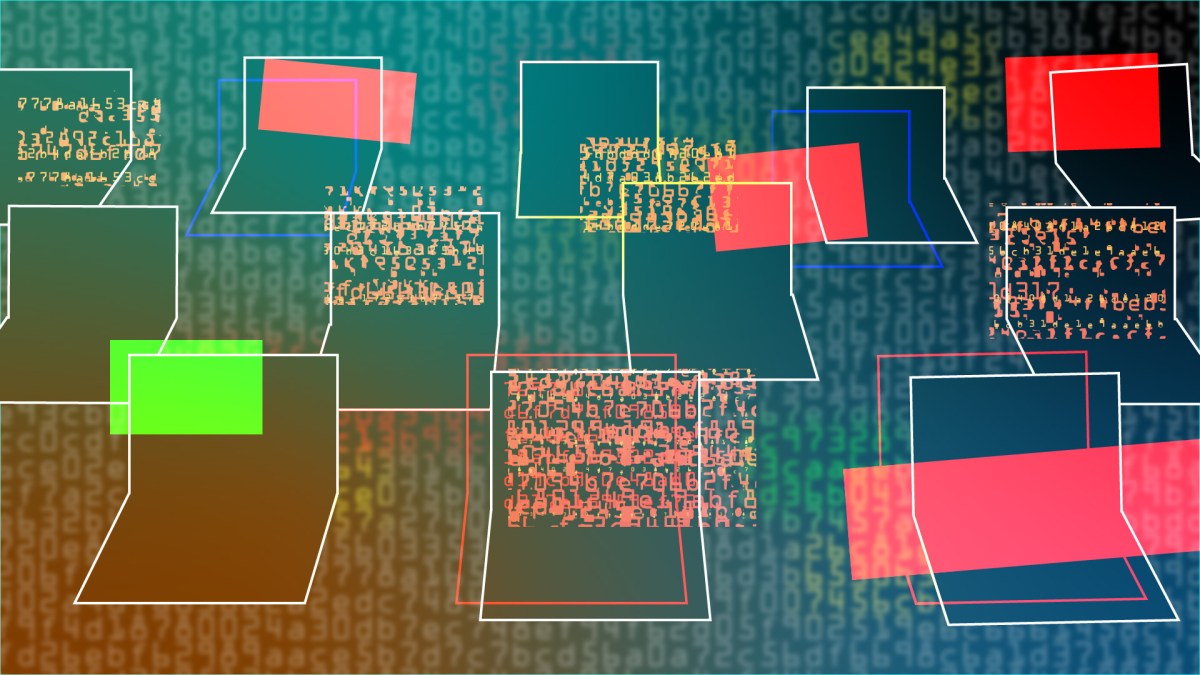The TechCrunch Cyber Glossary | TechCrunch
[ad_1]
The cybersecurity world is full of technical lingo and jargon. At TechCrunch, we have been writing about cybersecurity for years, and even we usually need a refresher on what exactly a specific phrase or expression means. That’s why we have created this glossary, which includes a few of the most typical — and by no means so frequent — phrases and expressions that we use in our articles, and explanations of how, and why, we use them.
This generally is a rising compendium, and we’ll exchange it often.
A classy persistent menace (APT) is usually categorized as a hacker, or group of hackers, which helpful properties and maintains unauthorized entry to a targeted system. The first intention of an APT intruder is to remain undetected for prolonged durations of time, often to conduct espionage and surveillance, to steal data, or sabotage essential strategies.
APTs are traditionally well-resourced hackers, along with the funding to pay for his or her malicious campaigns, and entry to hacking devices typically reserved by governments. As such, a lot of the long-running APT groups are associated to nation states, like China, Iran, North Korea, and Russia. In current instances, we’ve seen examples of non-nation state cybercriminal groups which is perhaps financially motivated (harking back to theft and money laundering) ending up cyberattacks comparable on the subject of persistence and capabilities as some typical government-backed APT groups.
(See: Hacker)
The pliability to run directions or malicious code on an affected system, often on account of a security vulnerability inside the system’s software program program. Arbitrary code execution could also be achieved each remotely or with bodily entry to an affected system (harking back to anyone’s system). Throughout the circumstances the place arbitrary code execution could also be achieved over the net, security researchers typically identify this distant code execution.
Normally, code execution is used as an answer to plant a once more door for sustaining long-term and persistent entry to that system, or for working malware that may be utilized to entry deeper parts of the system or totally different devices on the similar group.
(See moreover: Distant code execution)
Botnets are networks of hijacked internet-connected devices, harking back to webcams and residential routers, which had been compromised by malware (or usually weak or default passwords) for the wants of being utilized in cyberattacks. Botnets could also be made up of an entire lot or a whole bunch of devices and are typically managed by a command-and-control server that sends out directions to ensnared devices. Botnets might be utilized for quite a lot of malicious causes, like using the distributed group of devices to masks and defend the net guests of cybercriminals, ship malware, or harness their collective bandwidth to maliciously crash websites and on-line suppliers with huge portions of junk internet guests.
(See moreover: Command-and-control server; Distributed denial-of-service)
A bug is definitely the explanation for a software program program glitch, harking back to an error or a difficulty that causes the software program program to crash or behave in an shocking methodology. In some circumstances, a bug generally is a security vulnerability.
The time interval “bug” originated in 1947, at a time when early pc techniques had been the size of rooms and made up of heavy mechanical and shifting gear. The first recognized incident of a bug current in a computer was when a moth disrupted the electronics of definitely one among these room-sized pc techniques.
(See moreover: Vulnerability)
Command-and-control servers (additionally known as C2 servers) are utilized by cybercriminals to remotely deal with and administration their fleets of compromised devices and launch cyberattacks, harking back to delivering malware over the net and launching distributed denial-of-service assaults.
(See moreover: Botnet; Distributed denial-of-service)
Cryptojacking is when a instrument’s computational vitality is used, with or with out the proprietor’s permission, to generate cryptocurrency. Builders usually bundle code in apps and on websites, which then makes use of the system’s processors to complete superior mathematical calculations needed to create new cryptocurrency. The generated cryptocurrency is then deposited in digital wallets owned by the developer.
Some malicious hackers use malware to deliberately compromise large numbers of unwitting pc techniques to generate cryptocurrency on a giant and distributed scale.
As soon as we talk about data breaches, we lastly suggest the improper eradicating of data from the place it should have been. Nonetheless the circumstances matter and will alter the terminology we use to clarify a particular incident.
A data breach is when protected data was confirmed to have improperly left a system from the place it was initially saved and usually confirmed when anyone discovers the compromised data. As a rule, we’re referring to the exfiltration of data by a malicious cyberattacker or in every other case detected on account of an inadvertent publicity. Counting on what is known regarding the incident, we may describe it in extra specific phrases the place particulars are recognized.
(See moreover: Data publicity; Data leak)
A data publicity (a type of data breach) is when protected data is saved on a system that has no entry controls, harking back to on account of human error or a misconfiguration. This may occasionally embrace circumstances the place a system or database is expounded to the net nevertheless and never utilizing a password. Just because data was uncovered doesn’t suggest the knowledge was actively discovered, nevertheless nevertheless could nonetheless be considered an data breach.
A data leak (a type of data breach) is the place protected data is saved on a system in a way that it was allowed to flee, harking back to due to a beforehand unknown vulnerability inside the system or by means of insider entry (harking back to an employee). A data leak can suggest that data could have been exfiltrated or in every other case collected, nevertheless there couldn’t on a regular basis be the technical means, harking back to logs, to know for sure.
A distributed denial-of-service, or DDoS, is a sort of cyberattack that features flooding targets on the internet with junk web guests with a view to overload and crash the servers and set off the service, harking back to a site, on-line retailer, or gaming platform to go down.
DDoS assaults are launched by botnets, which are made up of networks of hacked internet-connected devices (harking back to home routers and webcams) that could be remotely managed by a malicious operator, usually from a command-and-control server. Botnets could also be made up of an entire lot or a whole bunch of hijacked devices.
Whereas a DDoS is a sort of cyberattack, these data-flooding assaults are often not “hacks” in themselves, as they don’t comprise the breach and exfiltration of data from their targets, nevertheless in its place set off a “denial of service” event to the affected service.
(See moreover: Botnet; Command-and-control server)
Encryption is one of the best ways and means via which data, harking back to recordsdata, paperwork, and private messages, are scrambled to make the knowledge unreadable to anyone aside from to its supposed proprietor or recipient. Encrypted data is often scrambled using an encryption algorithm — principally a set of mathematical formulation that determines how the knowledge must be encrypted — along with a private key, harking back to a password, which might be utilized to unscramble (or “decrypt”) the protected data.
Virtually all stylish encryption algorithms in use at current are open provide, allowing anyone (along with security professionals and cryptographers) to analysis and confirm the algorithm to make sure it’s free of faults or flaws. Some encryption algorithms are stronger than others, meaning data protected by some weaker algorithms could also be decrypted by harnessing large portions of computational vitality.
Encryption is totally totally different from encoding, which merely converts data into a definite and standardized format, usually for the advantage of allowing pc techniques to study the knowledge.
End-to-end encryption (or E2EE) is a security attribute constructed into many messaging and file-sharing apps, and is broadly considered one among many strongest strategies of securing digital communications as they traverse the net.
E2EE scrambles the file or message on the sender’s system sooner than it’s despatched in a way that permits solely the supposed recipient to decrypt its contents, making it near-impossible for anyone — along with a malicious hacker, and even the app maker — to snoop inside on anyone’s personal communications. In current instances, E2EE has flip into the default security commonplace for lots of messaging apps, along with Apple’s iMessage, Fb Messenger, Signal, and WhatsApp.
E2EE has moreover flip into the subject of governmental frustration in current instances, as encryption makes it not attainable for tech companies or app suppliers to current over data that they themselves wouldn’t have entry to.
Most stylish strategies are protected with a lot of layers of security, along with the facility to set individual accounts with further restricted entry to the underlying system’s configurations and settings. This prevents these prospects — or anyone with improper entry to definitely one among these individual accounts — from tampering with the core underlying system. Nonetheless, an “escalation of privileges” event can comprise exploiting a bug or tricking the system into granting the individual further entry rights than they should have.
Malware can also benefit from bugs or flaws attributable to escalation of privileges by gaining deeper entry to a instrument or a associated group, doubtlessly allowing the malware to unfold.
An exploit is one of the best ways and means via which a vulnerability is abused or taken good thing about, usually with a view to interrupt proper right into a system.
(See moreover: Bug; Vulnerability)
Usually phrases, extortion is the act of buying one factor, usually money, by way of the utilization of energy and intimidation. Cyber extortion isn’t any fully totally different, as a result of it typically refers to a category of cybercrime whereby attackers demand value from victims by threatening to wreck, disrupt, or expose their delicate data.
Extortion is usually utilized in ransomware assaults, the place hackers typically exfiltrate agency data sooner than demanding a ransom value from the hacked sufferer. Nonetheless extortion has quickly flip into its private class of cybercrime, with many, often youthful, financially motivated hackers, opting to carry out extortion-only assaults, which snub the utilization of encryption in favor of straightforward data theft.
(Moreover see: Ransomware)
There isn’t a such factor as a one single definition of “hacker.” The time interval has its private rich historic previous, custom, and meaning inside the security neighborhood. Some incorrectly conflate hackers, or hacking, with wrongdoing.
By our definition and use, we broadly focus on with a “hacker” as anyone who’s a “breaker of points,” usually by altering how one factor works to make it perform otherwise with a view to satisfy their targets. In observe, that could be one factor as simple as repairing a machine with non-official parts to make it function otherwise as supposed, or work even larger.
Throughout the cybersecurity sense, a hacker is often anyone who breaks a system or breaks the security of a system. Which will very properly be one thing from an internet-connected laptop computer system to a straightforward door lock. Nonetheless the person’s intentions and motivations (if recognized) matter in our reporting, and guides how we exactly describe the person, or their train.
There are ethical and approved variations between a hacker who works as a security researcher, who’s professionally tasked with breaking into a company’s strategies with their permission to determine security weaknesses that could be mounted sooner than a malicious specific individual has a chance to make use of them; and a malicious hacker who helpful properties unauthorized entry to a system and steals data with out buying anyone’s permission.
On account of the time interval “hacker” is inherently neutral, we sometimes apply descriptors in our reporting to produce context about who we’re talking about. If everyone knows that an individual works for a authorities and is contracted to maliciously steal data from a rival authorities, we’re extra prone to describe them as a nation-state or authorities hacker (or, if relevant, a sophisticated persistent menace), for example. If a gang is known to utilize malware to steal funds from individuals’ monetary establishment accounts, we may describe them as financially motivated hackers, or if there’s proof of criminality or illegality (harking back to an indictment), we may describe them merely as cybercriminals.
And, if we don’t know motivations or intentions, or a person describes themselves as such, we may merely focus on with a subject neutrally as a “hacker,” the place relevant.
(Moreover see: Superior persistent menace; Unauthorized)
Transient for “data security,” one other time interval used to clarify defensive cybersecurity focused on the security of data and knowledge. “Infosec” is also the favored time interval for commerce veterans, whereas the time interval “cybersecurity” has flip into broadly accepted. In stylish cases, the two phrases have flip into largely interchangeable.
Infostealers are malware in a position to stealing data from a person’s laptop computer or system. Infostealers are typically bundled in pirated software program program, like Redline, which when put in will primarily seek out passwords and totally different credentials saved inside the particular person’s browser or password supervisor, then surreptitiously add the sufferer’s passwords to the attacker’s strategies. This lets the attacker examine in using these stolen passwords. Some infostealers are moreover in a position to stealing session tokens from an individual’s browser, which enable the attacker to examine in to a person’s on-line account as within the occasion that they’d been that individual nevertheless without having their password or multifactor authentication code.
(See moreover: Malware)
Jailbreaking is utilized in a lot of contexts to suggest the utilization of exploits and totally different hacking strategies to keep away from the security of a instrument, or eradicating the restrictions a producer locations on {{hardware}} or software program program. Throughout the context of iPhones, for example, a jailbreak is a technique to remove Apple’s restrictions on placing in apps open air of its “walled yard” or to realize the facility to conduct security evaluation on Apple devices, which is usually extraordinarily restricted. Throughout the context of AI, jailbreaking means figuring out an answer to get a chatbot to current out data that it’s not imagined to.
The kernel, as its title suggests, is the core part of an working system that connects and controls practically all {{hardware}} and software program program. As such, the kernel has the very best diploma of privileges, meaning it has entry to almost any data on the system. That’s why, for example, apps harking back to antivirus and anti-cheat software program program run on the kernel diploma, as they require broad entry to the system. Having kernel entry permits these apps to look at for malicious code.
Malware is a broad umbrella time interval that describes malicious software program program. Malware can land in a number of varieties and be used to make use of strategies in a number of strategies. As such, malware that is used for specific capabilities can often be referred to as its private subcategory. As an illustration, the type of malware used for conducting surveillance on people’s devices can be known as “adware and adware,” whereas malware that encrypts recordsdata and requires money from its victims is called “ransomware.”
(See moreover: Infostealers; Ransomware; Spy ware)
Metadata is data about one factor digital, considerably than its contents. Which will embrace particulars regarding the measurement of a file or doc, who created it, and when, or inside the case of digital photos, the place the image was taken and particulars in regards to the system that took the image. Metadata couldn’t set up the contents of a file, nevertheless it could be useful in determining the place a doc bought right here from or who authored it. Metadata can also focus on with particulars about an alternate, harking back to who made a reputation or despatched a textual content material message, nevertheless not the contents of the choice or the message.
Ransomware is a type of malicious software program program (or malware) that stops system householders from accessing its data, typically by encrypting the person’s recordsdata. Ransomware is often deployed by cybercriminal gangs who demand a ransom value — usually cryptocurrency — in return for providing the private key to decrypt the person’s data.
In some circumstances, ransomware gangs will steal the sufferer’s data sooner than encrypting it, allowing the criminals to extort the sufferer extra by threatening to publish the recordsdata on-line. Paying a ransomware gang isn’t any guarantee that the sufferer will get their stolen data once more, or that the gang will delete the stolen data.
One in every of many first-ever ransomware assaults was documented in 1989, via which malware was distributed by the use of floppy disk (an early sort of removable storage) to attendees of the World Effectively being Group’s AIDS conference. Since then, ransomware has superior proper right into a multi-billion buck authorized commerce as attackers refine their methods and hone in on big-name firm victims.
(See moreover: Malware; Sanctions)
Distant code execution refers again to the potential to run directions or malicious code (harking back to malware) on a system from over a group, often the net, with out requiring any human interaction from the objective. Distant code execution assaults can differ in complexity nevertheless could also be extraordinarily damaging when vulnerabilities are exploited.
(See moreover: Arbitrary code execution)
Cybersecurity-related sanctions work equally to standard sanctions in that they make it illegal for firms or individuals to transact with a sanctioned entity. Throughout the case of cyber sanctions, these entities are suspected of ending up malicious cyber-enabled actions, harking back to ransomware assaults or the laundering of ransom funds made to hackers.
The U.S. Treasury’s Office of Abroad Belongings Administration (OFAC) administers sanctions. The Treasury’s Cyber-Related Sanctions Program was established in 2015 as part of the Obama administration’s response to cyberattacks specializing in U.S. authorities firms and private sector U.S. entities.
Whereas a relatively new addition to the U.S. authorities’s bureaucratic armory in direction of ransomware groups, sanctions are increasingly used to hamper and deter malicious state actors from conducting cyberattacks. Sanctions are typically used in direction of hackers who’re out of attain of U.S. indictments or arrest warrants, harking back to ransomware crews based in Russia.
A broad time interval, like malware, that covers quite a lot of surveillance monitoring software program program. Spy ware is often used to debate with malware made by personal companies, harking back to NSO Group’s Pegasus, Intellexa’s Predator, and Hacking Workers’s Distant Administration System, amongst others, which the companies promote to authorities firms. In extra generic phrases, a few of these malware are like distant entry devices, which allows their operators — usually authorities brokers — to spy and monitor their targets, giving them the facility to entry a instrument’s digicam and microphone or exfiltrate data. Spy ware can be referred to as enterprise or authorities adware and adware, or mercenary adware and adware.
(See moreover: Stalkerware)
Stalkerware is a sort of surveillance malware (and a sort of adware and adware) that is usually supplied to uncommon prospects beneath the guise of child or employee monitoring software program program nevertheless is usually used for the wants of spying on the telephones of unwitting individuals, oftentimes spouses and residential companions. The adware and adware grants entry to the objective’s messages, location, and additional. Stalkerware typically requires bodily entry to a objective’s system, which provides the attacker the facility to place in it immediately on the objective’s system, usually because the attacker is conscious of the objective’s passcode.
(See moreover: Spy ware)
What are you attempting to protect? Who’re you nervous about which may go after you or your data? How could these attackers get to the knowledge? The options to these types of questions are what’s going to lead you to create a menace model. In several phrases, menace modeling is a course of that an organization or an individual has to endure to design software program program that is secure, and devise strategies to secure it. A menace model could also be focused and specific counting on the state of affairs. A human rights activist in an authoritarian nation has a definite set of adversaries, and data, to protect than a giant firm in a democratic nation that is nervous about ransomware, for example.
As soon as we describe “unauthorized” entry, we’re referring to the accessing of a computer system by breaking any of its security options, harking back to a login quick or a password, which is perhaps considered illegal beneath the U.S. Laptop Fraud and Abuse Act, or the CFAA. The Supreme Courtroom docket in 2021 clarified the CFAA, discovering that accessing a system lacking any strategy of authorization — for example, a database with no password — won’t be illegal, as you can’t break a security attribute that isn’t there.
It’s worth noting that “unauthorized” is a broadly used time interval and sometimes utilized by companies subjectively, and as such has been used to clarify malicious hackers who steal anyone’s password to interrupt in by way of to incidents of insider entry or abuse by employees.
A digital personal group, or VPN, is a networking know-how that permits anyone to “practically” entry a private group, harking back to their workplace or home, from wherever else on this planet. Many use a VPN provider to browse the online, contemplating that this could help to steer clear of on-line surveillance.
TechCrunch has a skeptics’ data to VPNs which will help you establish if a VPN is wise for you. If it does, we’ll current you learn the way to rearrange your private personal and encrypted VPN server that solely you administration. And if it doesn’t, we uncover a couple of of the privateness devices and totally different measures you’ll take to meaningfully improve your privateness on-line.
A vulnerability (moreover referred to as a security flaw) is a type of bug that causes software program program to crash or behave in an shocking methodology that impacts the security of the system or its data. Usually, two or further vulnerabilities might be utilized in conjunction with each other — known as “vulnerability chaining” — to realize deeper entry to a targeted system.
(See moreover: Bug; Exploit)
A zero-day is a specific kind of security vulnerability that has been publicly disclosed or exploited nevertheless the seller who makes the affected {{hardware}} or software program program has not been given time (or “zero days”) to restore the difficulty. As such, there is also no fast restore or mitigation to cease an affected system from being compromised. This can be considerably problematic for internet-connected devices.
(See moreover: Vulnerability)
Closing updated on November 5, 2024.
[ad_2]
Provide hyperlink














Post Comment